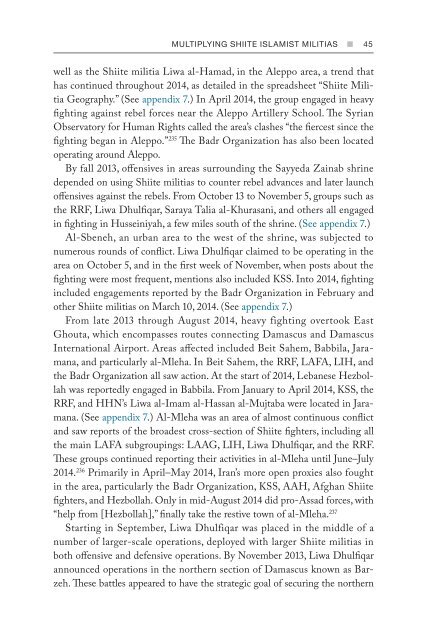You also want an ePaper? Increase the reach of your titles
YUMPU automatically turns print PDFs into web optimized ePapers that Google loves.
MULTIPLY<strong>IN</strong>G <strong>SHIITE</strong> ISLAMIST MILITIAS n 45<br />
well as the Shiite militia Liwa al-Hamad, in the Aleppo area, a trend that<br />
has continued throughout 2014, as detailed in the spreadsheet “Shiite Militia<br />
Geography.” (See appendix 7.) In April 2014, the group engaged in heavy<br />
fighting against rebel forces near the Aleppo Artillery School. The Syrian<br />
Observatory for Human Rights called the area’s clashes “the fiercest since the<br />
fighting began in Aleppo.” 235 The Badr Organization has also been located<br />
operating around Aleppo.<br />
By fall 2013, offensives in areas surrounding the Sayyeda Zainab shrine<br />
depended on using Shiite militias to counter rebel advances and later launch<br />
offensives against the rebels. From October 13 to November 5, groups such as<br />
the RRF, Liwa Dhulfiqar, Saraya Talia al-Khurasani, and others all engaged<br />
in fighting in Husseiniyah, a few miles south of the shrine. (See appendix 7.)<br />
Al-Sbeneh, an urban area to the west of the shrine, was subjected to<br />
numerous rounds of conflict. Liwa Dhulfiqar claimed to be operating in the<br />
area on October 5, and in the first week of November, when posts about the<br />
fighting were most frequent, mentions also included KSS. Into 2014, fighting<br />
included engagements reported by the Badr Organization in February and<br />
other Shiite militias on March 10, 2014. (See appendix 7.)<br />
From late 2013 through August 2014, heavy fighting overtook East<br />
Ghouta, which encompasses routes connecting Damascus and Damascus<br />
International Airport. Areas affected included Beit Sahem, Babbila, Jaramana,<br />
and particularly al-Mleha. In Beit Sahem, the RRF, LAFA, LIH, and<br />
the Badr Organization all saw action. At the start of 2014, Lebanese Hezbollah<br />
was reportedly engaged in Babbila. From January to April 2014, KSS, the<br />
RRF, and HHN’s Liwa al-Imam al-Hassan al-Mujtaba were located in Jaramana.<br />
(See appendix 7.) Al-Mleha was an area of almost continuous conflict<br />
and saw reports of the broadest cross-section of Shiite fighters, including all<br />
the main LAFA subgroupings: LAAG, LIH, Liwa Dhulfiqar, and the RRF.<br />
These groups continued reporting their activities in al-Mleha until June–July<br />
2014. 236 Primarily in April–May 2014, Iran’s more open proxies also fought<br />
in the area, particularly the Badr Organization, KSS, AAH, Afghan Shiite<br />
fighters, and Hezbollah. Only in mid-August 2014 did pro-Assad forces, with<br />
“help from [Hezbollah],” finally take the restive town of al-Mleha. 237<br />
Starting in September, Liwa Dhulfiqar was placed in the middle of a<br />
number of larger-scale operations, deployed with larger Shiite militias in<br />
both offensive and defensive operations. By November 2013, Liwa Dhulfiqar<br />
announced operations in the northern section of Damascus known as Barzeh.<br />
These battles appeared to have the strategic goal of securing the northern


